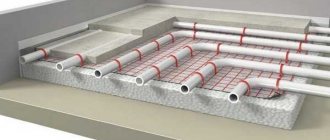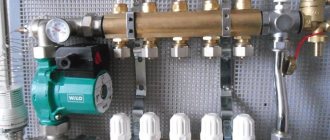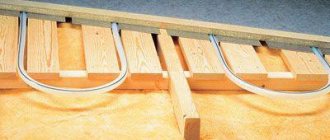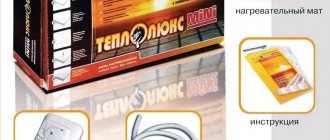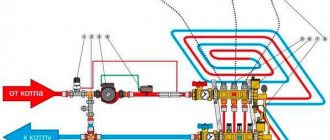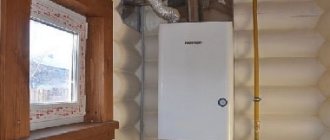Thermal insulation is one of the important components of underfloor heating systems, allowing for efficient energy consumption. An insulating layer is needed to reduce the load on heating equipment and to maintain the resulting microclimatic parameters. It prevents heat from leaking through the ceiling into unheated areas and sets the required direction of heat flow. Expanded polystyrene copes with the listed tasks better than all known insulation materials: for heated floors it is generally recognized as the best option.
The well-known technical term “expanded polystyrene” combines several types of thermal insulation products. They differ in characteristics, areas of application and installation methods. Information about the differences will help you determine what is best to buy for installing an underfloor heating system with specific technical data.
- 2 Technical and technological advantages of polystyrene foam
2.1 Specifics of foil insulation - 2.2 Expanded polystyrene boards with bosses
What is expanded polystyrene
Expanded polystyrene is a foamed polymer substance. It is produced by foaming the mass by adding a low-boiling liquid to it. As a result, granules with a waterproof shell are formed.
Then, they are exposed to hot steam, which leads to their increase in size up to 30 times. The granules, connecting with each other, form polystyrene foam boards having a high density. This product is unique because, despite its lightness and airiness, it can withstand pressure and compression.
German scientists managed to obtain this material in the 20th century, as a result of the synthesis of styrene, a chemical substance that was released when Styrax resin was heated.
What material is most often chosen for water floor insulation?
Extruded polystyrene is most often used to insulate water floors. When compared with traditional, less expensive polystyrene foam, it is difficult to find a difference in thermal insulation coefficients. Both materials have almost identical protection properties in terms of thermal insulation coefficient. Why then do they prefer the extruded polystyrene insulation method? On the one hand, this is a marketing ploy, recommendations from manufacturers of warm water floors, on the other hand, a replicated opinion that is accepted as truth.
But, besides this, there is still one important nuance that installers of warm water floors and customers often forget about until they encounter it - the density of the material plays a significant role in obtaining the quality of the work. And in this case, extruded polystyrene comes out on top - almost all slabs made from this material have a density of 15 kg per cubic meter, but cheaper foam plastic is much lighter (less dense) in most cases. But there are sheets of foam plastic that have a density of up to 35 kg per cubic meter, suitable for insulation and attaching heated floors directly to the insulation. They are less common and you need to look for a manufacturer offering such foam.
Why do you need insulation at all if you are installing a water-heated floor?
- Ensuring high-quality thermal insulation of the floor slab of a house or apartment.
- Reducing heat dissipation from pipes in the wrong direction.
- Optimization of heat loss.
- Serves as a basis for quick fastening of pipes.
- Additional sound insulation.
Coolant mounting methods
There are different ways to attach the coolant when installing heated floors:
- Reinforcing mesh - water system pipes or electrical cables are secured to the mesh with plastic ties. In places where the heating elements are bent by 90 degrees, 2 pieces of tie are enough, and when turning by 180, you need to fix them in 3 places.
The advantages of this method are ease of operation and reliability. The disadvantages are the labor-intensive process, the possibility of damage to the pipe materials on the mesh during operation of the system, if they are made of metal-plastic. In addition, the thermal efficiency of the floor may be reduced due to voids between the pipes and the mesh.
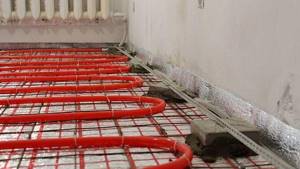
- Plastic guides - placed on polystyrene foam with a smooth surface. They can be different in length, connected by inserting one into the other, and secured with clasps. Before fixing them, you should decide on the layout of the heating elements. To secure the guides, plastic brackets are used, which are installed on polystyrene.
The advantages are the speed and convenience of laying out pipe-rolling materials and their reliable fixation. Disadvantages - the marking process is complicated and there is no mesh to reinforce the screed.
For your information! It is possible to make guides yourself from wooden slats.
- Plates with bosses - no additional fixation is required, since the bosses are guide parts, the coolant is laid between them according to any pattern. The mats make it easier to install pipe materials, and the bosses protect them from damage. The main disadvantage is the high price of the slabs.
- The use of Velcro is a new method of fastening. Fixation is done by wrapping the pipes with adhesive tape, which is attached to the base. This method is quick and convenient and does not require additional fixation. The downside is that installation becomes more complicated due to the lack of markings, and slight shifting is possible when walking on the floor.
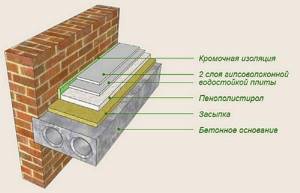
Everyone can choose a thermal insulation material for heated floors, a method of arrangement and fixation of the coolant according to their wishes and financial capabilities.
People who have experience in working with thermal insulation can install extruded polystyrene foam themselves without foil, fastenings and markings. If you do not have this experience and do not rely on your own strength, then you should invite specialists to install a warm system with a polystyrene foam backing.
Varieties of expanded polystyrene for use in heated floors
There are different types of material in question. Each of them has important features that must be taken into account when installing heated floors.
Profile
Such polystyrene boards are multilayer. The upper part is made of rigid vapor barrier material. Its high mechanical strength protects the insulation from destruction. They do not create a greenhouse effect.
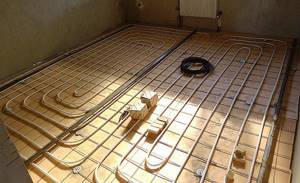
There are side locks that allow the slabs to be hermetically joined together. The lower surface is made in relief, it allows you to smooth out the unevenness of the base.
Foil polystyrene
This type of polystyrene foam for a warm water floor is a mixed material. A layer of polished foil with an aluminum layer is applied to ordinary polystyrene foam on one or both sides. Instead of the latter, metallized polypropylene film can be used.
This polystyrene material is well suited for underfloor heating. The metallized film will reflect the sun's rays, protecting the material from ultraviolet radiation.
Unpressed
This type of foam for heated floors is considered the cheapest. It is obtained by drying granules. The procedure is performed at a temperature of 80 degrees, again melting the composition. Then drying is repeated again. These steps are repeated several times, after which they are poured into the mold and wait until completely dry.
During production, half the amount of isopentane is consumed than in the usual case. As a result, production costs are reduced. The unpressed variety of polystyrene foam is less durable.
Extruded thermal insulation material
This foam plastic for underfloor heating is distinguished by the fact that high temperature and pressure are used to produce granules. During the manufacturing process of such extruded material, the required amount of carbon dioxide and a mixture of various freons are introduced.
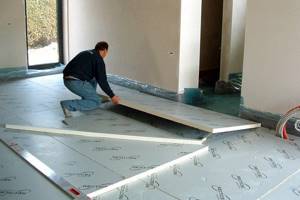
The resulting composition is squeezed through an extruder. After drying, the material will be ready for use. It has a higher density than usual.
Pressed and autoclaved
The process of producing autoclaved material is practically no different from creating extruded material. The difference lies in the use of an autoclave during the foaming or sintering procedure of the granules.
What are polystyrene foam boards
The term “expanded polystyrene” means a material made by foaming polystyrene. Plates made from it are the final product for thermal insulation.
The main advantages of expanded polystyrene are its small thickness, light weight, ease of installation and affordable cost.
Important! When installing heated floors using slabs, it is necessary to take into account the load and distribute it correctly!
The advantages of polystyrene foam for heated floors include:
- High heat retention performance. Its thermal conductivity coefficient is much lower than that of polystyrene foam, which makes it possible to lay slabs of smaller thickness.
- Good mechanical strength indicators make it possible to use it as a structural element for loaded structures, a reinforcing layer and an underlying layer.
- The heat resistance of expanded polystyrene makes it possible to use it regardless of temperature.
- Expanded polystyrene boards easily withstand the effects of chemical reagents and adverse environmental conditions.
- When making plates, molds can be used that form so-called bosses, which serve as protrusions for laying between them a heating element (tube), the diameter of which can be from 16 mm to 18 mm.
- The presence of side locks allows you to form boards from slabs without “clearings”, which in turn provides sufficient adhesion and avoids seams that cause thermal acoustics.
- Excellent sound insulation performance.
- Environmentally neutral and does not pose a threat to the human body.
- Absolutely resistant to microorganisms and fungi. Its synthetic base is a reliable barrier to putrefactive processes that can occur on other thermal insulation materials during operation.
- Moisture resistance is the main advantage of the material. Even with constant moisture on the slabs, they will not deform.
- A warm floor laid on expanded polystyrene slabs will not cause harmful fumes from heating the material, since its granules are carbon and hydrogen.
- Vapor barrier indicators are provided by air capsules in the composition of polystyrene foam. They are usually practically closed and impenetrable. Therefore, neither air nor steam can pass through the material. This is a wonderful vapor barrier that cannot accumulate moisture inside.
These advantages of the material became the starting point for installing floors, including warm ones.
Analogs of expanded polystyrene
There are a number of materials that can also be used as thermal insulation, but their characteristics are significantly inferior to expanded polystyrene.
These include:
- Cork slab - has a high cost.
- Mineral wool does not tolerate moisture well, is not suitable for installation on the ground, and is contraindicated when installing a heated water floor.
- Foamed polyethylene - the heaviness of the screed leads to a significant reduction in its thickness.
- Polystyrene foam is a less suitable material for warm floors, as it has a fragile structure and insufficient rigidity. It can be used in warm systems, but when there is no load.
Good to know! Despite the claims of manufacturers, polystyrene foam, especially when installing a heated water floor, requires good waterproofing. Otherwise, the degree of thermal insulation will significantly decrease under the influence of moisture.
On what basis can polystyrene foam be laid?
Foamed polymer slabs are produced in a variety of colors, which in no way affect the technical characteristics of the material. They can be laid on the following bases:
- on the ground, which is first compacted, and then a cushion of crushed stone and sand is made;
- on compacted gravel, protected from moisture penetration;
- on a concrete base, pre-coated with waterproofing material;
- on a wooden base covered with a layer of waterproofing.

Floor screed device for polystyrene foam
What to look for when choosing
When choosing expanded polystyrene for a heated floor, take into account its quality and variety.

Granular dense structure of polystyrene foam
Quality control
The quality of polystyrene foam boards that will be used for floor insulation can be judged by visual inspection. You will need to pay attention to the following:
- The product must have a bright, evenly distributed color. Typically, slabs of orange or blue color go on sale. This does not in any way affect the characteristics of the products, except for the tone and uniformity of color, which indicate the quality and compliance with the manufacturing technology of the slabs.
- The presence of a slight specific odor is acceptable, but there should not be a strong unpleasant odor.
- During a visual inspection, you must make sure that the slab has clear geometric dimensions, its edges are smooth and dense - they do not crumble when pressed.
- The surface of the slab must be flat, otherwise the thermal insulation properties will be significantly reduced.
- It is necessary to visually assess the quality of the granules - they must be the same size without voids.
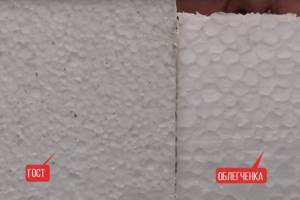
When choosing slabs, you should pay attention to their cut structure
Advice! By breaking a sample of a slab in half, you can evaluate its quality by looking at the location of the break. If the granules in this place have retained their integrity, then this indicates poor adhesion between them. If the slab is of high quality, then the granules are also destroyed at the fracture site.
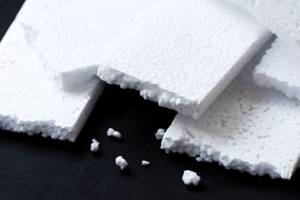
When broken, high-quality polystyrene foam granules also break due to strong adhesion
Kinds
The properties of expanded polystyrene directly depend on its production technology. In this regard, three types of material can be distinguished:
- Non-pressed polystyrene foam is produced by molding a mixture of granules pre-dried and foamed at a temperature of 80 degrees. This is the most budget option, which is characterized by high fragility.
- Material produced by extrusion (extruded polystyrene foam) is produced under the influence of a reagent, which is introduced into a container-form, followed by squeezing the foam mass into a slab shape and drying.
- When replacing the foaming reagent with an autoclave, the resulting material is not suitable for use as a heat insulator.
- Pressed boards with a thickness of 15 to 70 mm have similar characteristics to extruded polystyrene.
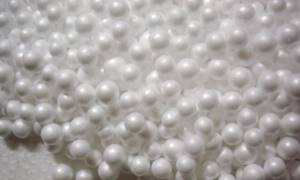
Expanded polystyrene balls can be used as insulation in wooden floors along joists
How to secure building material?
When installing heated floors, experts recommend using several fastening methods:
- Reinforcing mesh is most often used. This method of fastening polystyrene foam is more suitable for a water system, but can be used when laying an electrical cable. Where there are bends in the heating elements, 2 ties will be sufficient; in some places a maximum of three ties are used. The method is considered the easiest. Of course, we must take into account that the process itself is labor-intensive, but in Moscow there are enough specialists who can easily cope with all the tasks;
- The material can also be secured using plastic guides that are placed on polystyrene foam, but only if it has a smooth surface. Such fasteners may differ in size, but they are attached if they are inserted one into another. Such installation can be done quickly enough, and the fixation will be reliable. The only negative is that it is difficult to mark, since there is no grid;
- Most often, slabs with bosses are used; such a building material in itself can solve the problem with fasteners, because the bosses are the fasteners. Naturally, such slabs will cost more than other similar materials, but their quality is high.
We recommend: How to connect a heated floor?
Expanded polystyrene is a material that even a beginner can work with. It is enough just to select all the necessary material for floor insulation and carry out all the work yourself, otherwise, you can invite specialists.
- Related Posts
- How to install Grand Meyer underfloor heating?
- How are pipes for heated floors installed?
- How does the underfloor heating calculator work?
- How is the mesh for underfloor heating installed?
- How to connect a warm floor?
- How to choose a wire for a heated floor?
Advantages and disadvantages of expanded polystyrene
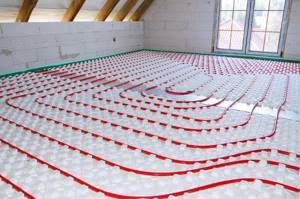
Expanded polystyrene has its pros and cons, so before making a choice in favor of this insulation, you need to know its advantages and disadvantages. The advantages include high noise-reducing properties, as well as durability. It does not allow water to pass through, does not rot and is not subject to fungi.
Polystyrene can last a very long time, and in comparison with other insulation for underfloor heating, it is considered a budget option. It can only deteriorate at critical temperatures, which are rare. But its technical properties have their own characteristics.
Some types of EPS can catch fire, but polystyrene foam for heated floors is extruded, and it is not afraid of fire. The greatest danger to the material is mechanical damage to the slabs. But if you lay extruded polystyrene foam under a warm floor, it will be safe. It is recommended to lay thermal insulation under the screed, then the room will retain heat better.
Insulation of concrete floors with granules
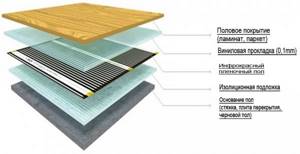
Expanded polystyrene for a warm concrete floor can be added directly to the solution and this mixture can be used for screeding. This interesting technology allows you to give the screed all the positive properties of PPS. Concrete does not allow noise to pass through, and the surface becomes especially warm. But a large number of balls reduces strength, so it is important to maintain a balance when using this method.
Technology for preparing concrete mortar with granules:
- Add some water to the cement;
- Start mixing the concrete solution;
- Without stopping stirring, add polystyrene foam;
- Achieve a uniform consistency.
The amount of granules must be determined independently, but it is recommended to use them at least 3 times more than the concrete solution, otherwise the thermal conductivity of the floors will be low. The floor covering is selected relative to the final rigidity of the screed made of concrete and EPS balls.
Expanded polystyrene and alternative insulation materials
There are many materials that can be used for floor insulation, but their use is abandoned for a number of reasons:
- Cork insulation is expensive.
- Mineral wool insulation is sensitive and cannot withstand the effects of moisture from groundwater, so it is not suitable for foundations on the ground and on floors above an unheated subfloor.
- Foamed polyethylene (foil or regular) under the weight of the screed decreases in thickness several times.
- Polystyrene foam is a brittle material with insufficient rigidity. It can be used in a “warm floor” system, but with the condition that there is no load, for example, a wooden floor with joists.
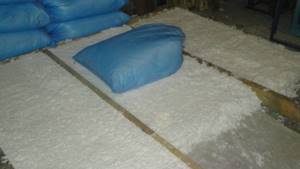
Bulk polystyrene insulation
When insulating the floor with polystyrene foam (loose or slab), it is laid in the free space between the joists, lined underneath with plywood or boards. A vapor barrier membrane is laid on top. A sheathing is secured along the joists, which will ensure high-quality ventilation. The flooring is made from plywood or other sheet material. It will serve as the basis for laying coolant loops along the guide rails.

Laying a thermal distribution plate on a wooden floor
At the final stage, the laid pipes or electrical cables are covered with sheet material (GVLV, OSB or plywood) in two offset layers, and the finishing decorative material is laid.
Important! Polystyrene foam and granulated styrene, no matter what manufacturers say, require high-quality waterproofing. The thermal insulation properties of insulation can be significantly reduced under the influence of moisture penetrating into the voids between the granules.
Expanded polystyrene boards with bosses
Polystyrene foam mats, specially designed for these purposes, are especially popular when laying heated floors. The so-called bosses on their surface make it possible to avoid the use of additional means of fixation, significantly facilitating the process of installing the coolant.
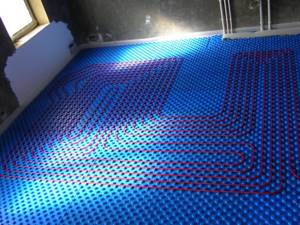
Slabs with bosses
The advantages of such plates include the following:
- The products are equipped with a rigid vapor barrier polystyrene foam layer that provides protection against condensation.
- The mat may have a laminated foil coating that protects it from the chemicals contained in the screed.
- Protruding elements (bosses) significantly simplify the installation of coolant.
- The mats are lightweight and have convenient dimensions, which makes them easy to transport and install.
- The presence of side locks ensures the immobility of the monolithic thermal insulation carpet structure, devoid of cold bridges and acoustic seams.
- The relief back surface is able to smooth out minor unevenness of the base, provides its ventilation and sound insulation.
- The long service life of the mats (up to 50 years) is achieved by following the rules of operation of the heated floor system.
- When pouring the screed, the embossed polystyrene foam mat does not change its thickness under its weight.
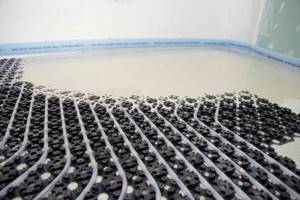
Filling mats with bosses with screed
Laying mats with coolant involves two methods for the final stages - pouring a screed or installing a flooring made of plywood, gypsum fiber or OSB boards. The second method is more reliable in terms of carrying out emergency repair work.
Video - Tips for laying polystyrene foam mats
Foil materials
Foil polystyrene has an additional layer with a reflective effect, which has a positive effect on the energy efficiency of the heated floor structure due to the uniform distribution of heat flows and heating of the room. The manufacturer applies markings to the surface of the foil layer, which simplify the work of fixing the coolant.

Laying pipes over foil insulation
Kinds
The quality of expanded polystyrene is influenced by production technology; various characteristics of the material and laying features depend on it. Several types of polystyrene are available.
Profile (expanded polystyrene mats)
Expanded polystyrene slabs, which were developed specifically for these systems, have gained particular popularity when installing heated floors. The main advantage of the mats is the special bosses located on their surface; they significantly simplify the installation of heating elements, since no additional parts are required for their fastening.
The positive aspects of such plates:
- the presence of a rigid vapor barrier polystyrene foam layer - protects against condensation;
- mats that have a foil laminated coating - it protects against the action of chemicals contained in the screed;
- light weight and size - simplifies installation;
- have side locks - a monolithic structure without acoustic and cold seams is obtained;
- the presence of a relief surface on the reverse side - allows you to smooth out small roughnesses of the base and creates conditions for its ventilation;
- service life (50 years) - provided that the underfloor heating system is properly operated;
- The thickness of the slab does not change under the weight of the screed.
Foil polystyrene
Expanded polystyrene with a foil layer is primarily intended for heated floors. Reflective foil helps to heat the room more efficiently, as heat is transferred evenly from the floor surface upward.
When installing a heated water floor, polystyrene foam must have a foil layer. The installation process will be facilitated by the use of foil polystyrene.
Advantages of this product:
- thermal resistance to temperature changes;
- excellent sound insulation;
- moisture resistance;
- does not emit toxic substances when heated;
- not subject to rotting.
Important! This material is contraindicated when installing infrared heated floors.
Unpressed
Unpressed polystyrene foam is made by molding a composition that is pre-dried and foamed at +80 degrees.
This is the cheapest material and is also the most fragile.
Video - laying insulation under a heated floor
Laying polystyrene foam on the floor
Extruded thermal insulation material
The extrusion process involves squeezing the mixture through an extruded device with heads into a slab shape, followed by drying. A reagent is first introduced into the material, leading to active foaming.
EPPS is a new variety, produced in the form of technoplex and premium foam. Today, extruded insulation for underfloor heating is becoming increasingly popular.
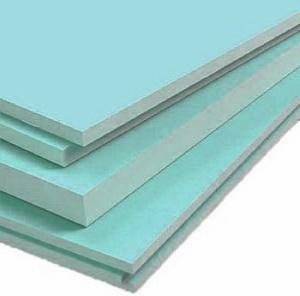
EPS is an ideal option as a substrate for heated floors, as it does not emit toxic substances from heating, and is considered the best heat insulator. However, it is quite fragile and is not a good sound insulator.
Pressed and autoclaved
Pressed material is similar to extruded material, but differs in production technology.
The manufacturing technology is the same, but the foaming of the granules is carried out in an autoclave. Autoclaved polystyrene is not suitable for thermal insulation of heated floors.
Watch the video
Floor insulation with polystyrene foam TechnoNIKOL
Tips and tricks for laying water-heated floors
Before work, you need to decide how thick the insulation should be. If the room below is heated, then it will be enough if you take 10-12 mm. Otherwise, you need to provide a layer with a thickness of at least 3 cm.
It is important to install heated floors, isolating them from moisture, otherwise they will largely lose their thermal insulation properties. To do this, place a waterproofing film underneath.
Warm floors made of polystyrene combine quality work and relative ease of installation. Unlike other options, it can be used in almost any home.
Recommendations for installation
Before starting installation work, you need to decide on the thickness of the thermal insulation layer. Keep in mind that in a private house you will need a larger layer of insulation (from 1 to 3 cm) than in heated apartments. For apartments, the recommended thickness is up to 1 cm.

Do not forget to lay moisture-proofing layers to avoid the accumulation of liquid in the layers of the heated floor.
Polystyrene foam as a type of thermal insulation is an excellent budget option for installation in all types of houses, combining reasonable prices and good insulating qualities. Do not forget about the rules for choosing and installing materials, this will greatly simplify your task.
- Related Posts
- How to check a heated floor?
- What is the difference between Unimat heated floor models?
- What are the characteristics of Aura underfloor heating?
- How to install a heated floor in a bathhouse?
- How is a heated floor connected?
- Features of heated floors made of metal-plastic pipes


